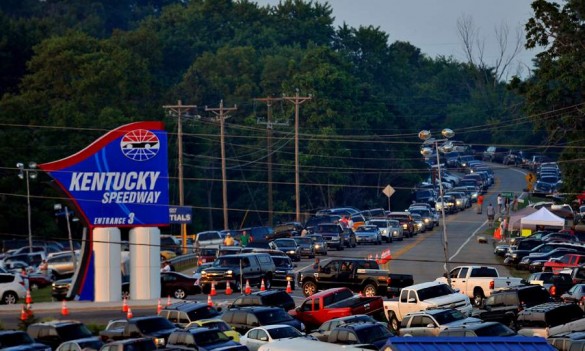
If you’re not into NASCAR, then you probably didn’t know that Saturday night was the running of the very first Sprint Cup race in Kentucky. If you are into NASCAR, you probably already had the date tattooed on your arm as a reminder (which is now a lasting memorial). Either way, you’ve more than likely heard of the awful traffic jam that is quickly becoming known as “Carmegeddon.”
Stories of drivers taking 4 hours to move 10 miles – and even some who spent 8 hours in their cars to move 30 miles – are beginning to surface. NASCAR’s Facebook and Twitter accounts were loaded with fans enraged because they were holding tickets to an event that they weren’t going to even get to, and many of those tweets and status updates were sent from their vehicles within sight of the speedway. Now everyone’e pointing a finger at someone else, because no one wants to answer the obvious question: how did it happen?
Apparently, in their rush to bring the highest level of NASCAR racing to a new location, officials spent a lot of time and money on necessary upgrades. The seating capacity was upped from just under 70,000 to just over 100,000, and 200 acres around the speedway were renovated to make room for RVs. Somehow, though, officials never thought about widening the roads enough to help those extra people get there. My guess is they were too busy counting the money from the record ticket sales.
My point in this column isn’t necessarily to paint NASCAR and Kentucky Speedway as villains, but rather to make what I think is a much more obvious point, and that is simply that when you build a place, you should probably also invest whatever it takes to make sure people can get to it.
Do not let your hearts be troubled. You believe in God; believe also in me. My Father’s house has many rooms; if that were not so, would I have told you that I am going there to prepare a place for you? And if I go and prepare a place for you, I will come back and take you to be with me that you also may be where I am. You know the way to the place where I am going. (John 14:1-4)
It’s encouraging to know that there’s a place that’s being prepared for us – one that is much greater than the Kentucky Speedway, or any other Speedway for that matter. For as long as many of us can remember, we’ve heard a great deal about this place. Streets that look like gold, lakes that look like crystal, with lots of loud music and singing. Many of us will have mansions there that will far exceed anything that we’ve seen here, and as great as all that stuff is, this place will pale in comparison to its Builder. Thomas (one of the disciples that Jesus was telling about The Place) totally got this and wanted to make sure he got there. Suddenly realizing he didn’t have a map, he asked Jesus how to get there (John 14:5) and Jesus answered with what is one of His most discussed sayings:
I am the way and the truth and the life. No one comes to the Father except through me. (John 14:6)
We could go into a lot of writing and comment posting about that one statement, couldn’t we?
About how counter-cultural it is that there’s only one way to The Place.
About how that means a lot of well-meaning people in other religions are wrong and about how that one un-PC statement makes a lot of people squirm.
About how the way He’s speaking of is a narrow road and not the eight lane interstate that the people in the NASCAR traffic jam were dreaming of.
Each of those naturally come up when we read that one statement, but if we dive into those, then I fear we’ll miss the most obvious truth – and the one most pertinent to this column…
Jesus built The Place, and He also invested what it took to make sure there was a way to get there.
He doesn’t stand next to the wonderful architecture of The Place and admire it while leaving all of us on our own to deal with a way that is inadequate for our journey. He didn’t go cheap on the infrastructure that The Place demanded. Instead of smelling the profits while leaving the travelers to smell exhaust fumes, He personally financed the building of the way and made sure that it was accessible to – and drivable by – all.
That kind of sacrifice is a lesson that so many of the officials pointing fingers after “Carmegeddon” should learn. It isn’t enough to just promote a great destination to people, because without a way to get there, the destination becomes little more than a dot on a map, a tantalizing carrot in front of a hungry horse, and in the end, the people you want to attract are too tired and frustrated to come back.
But the most important Place has more than just the bells and whistles and lots of rooms. It has a road that can handle all the people coming to it, and because it was paid for with the precious investment of Jesus’ own sacrifice on the cross for our sins, it’s a road that won’t fail when it’s needed most.
I know, because I’m on it, and there’s room in the lanes beside me for more.








Leave a Comment